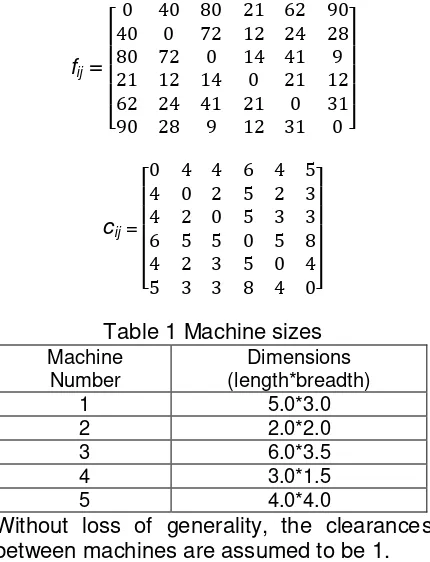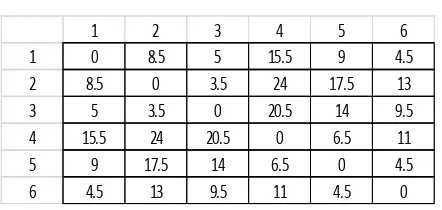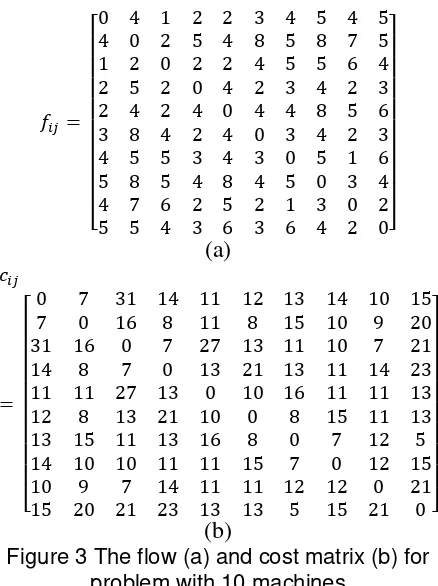INSERTION HEURISTIC FOR THE SINGLE ROW LAYOUT PROBLEM
IN FLEXIBLE MANUFACTURING SYSTEMS
Tjutju Tarliah Dimyati
Industrial Engineering Department, Pasundan University Jl. Dr. Setiabudhi 193 Bandung, Indonesia
E-mail : [email protected]
ABSTRACT
An important problem in a Flexible Manufacturing System (FMS) is to obtain a layout of machines such that material handling is the most efficient. Since poor layout would result in more parts spending longer time moving from one machine to another, developing layout for FMS is dealing with the arrangement of machines in the shop floor in order to minimize the total flow of parts in the system. In this paper, a single row layout problem is considered, and a heuristic approach, called the insertion heuristic, to solve the problem is proposed. The proposed approach is tested on benchmark problems available in the literature and the results are presented.
Key words: FMS, Single row unequal area layout, Insertion Heuristic.
1. INTRODUCTION
A flexible manufacturing system (FMS) is a production system consists of a group of flexible machine linked together by a material handling system which is controlled by a central computer. The system is designed to provide an effective operation sequence to fulfil the production requirements and reasonably allocate the resources. Machines in any FMS are an important resource and it is critical to ensure that they do not unnecessarily remain idle because of a badly designed material handling system. Therefore, an important problem in a FMS is to obtain an effective layout of the machines, i.e., an optimum arrangement of the machines in the shop floor so that to provide efficient operation (Heragu and Kusiak, 1988).
The layout of machines in a FMS is typically determined by the type of material-handling device used such as material-handling robots, automated guided vehicles (AGVs), gantry robots, etc. In practice, the most commonly used types of machine layouts are the linear single-row layout, the linear double-row layout, the cluster layout based on gantry robot, the semi-circular layout with a single robot and the closed-loop layout (Kusiak, 1990). Among these layouts, the most efficient material handling occurs when robots or AGVs move in a straight line, and
hence the problem of laying out machines is one of laying them out in a single row (Solimanpur et al. 2005). This could be due to the fact that the single row layout has ability to support different type of material handling system.
Figure 1: Single row machine layout with AGV
The objective of this paper is to propose an insertion heuristic approach to solve a single row layout problem in which the machine sizes are not equal, and therefore, the distance between machines is sequence dependent.
2. LITERATURE REVIEW
The facility layout problem is belongs to NP-Complete type, where the complexity of the problem exponentially increases with the number of facilities. Therefore, several heuristics have been developed to solve this problem for a near-optimal solution.
Drezner (1987) proposed a heuristic method for solving the problem, which is based on the eigenvectors of a transformed flow matrix. Another heuristic has been proposed by Heragu and Kusiak (1988) to solve the single-row machine layout problem in FMS. In this heuristic, a pair of facilities with the largest adjusted flow is initially laid and then the partial order is gradually completed through a loop adding new machines to the right and left of the order obtained in the previous iteration.
Another heuristic was presented in Kumar et al. (1995). This heuristic ignored the lengths of the facilities, and tried to assign facilities with the largest inter-facility weight to adjacent locations in the solution. It allowed the assignment of more than one facility to an existing sequence of facilities at any iteration in the heuristic. A greedy heuristic was presented in Braglia (1997). It derived ideas from another heuristic for a scheduling problem. An insertion based two step heuristic was proposed in Djellab and Gourgand (2001) to solve the Single Row Facility Layout Problem.
Improvement heuristics based on Simulated Annealing (Romero and Sanchez-Flores 1990, Kouvelis and Chiang 1992, Heragu and Alfa 1992) were used to obtain single row machine layouts for FMSs. Later, Ant Colony Optimization (Solimanpur et al. 2005), and scatter search (Kumar et al. 2008) have been used to solve the machine layout problems in FMSs. Tabu Search (Samarghandi and Eshghi 2010), Particle Swarm Optimization (Samarghandi et al. 2010), and Genetic Algorithms (Datta et al. 2011) have also been used to solve the SRFLP.
These studies clearly demonstrate continuing interest of researchers to solve
the single row machine layout problem in FMS.
3. PROBLEM STATEMENT
Define m as the number of machines to be located, fij as the frequency of transport
between machine i and j, cijas the variable
transport cost, and Lij as the centroidal
distance between the machines i and j. The problem is to sequence the machines on the factory shop floor in a single row layout, such that the total material handling cost is minimized.
In order to determine Lij, the dimensions of
the machines and the clearance, i.e. the minimum allowable distances between the adjacent machines, (dij) need to be known.
It is assumed that:
a. AGV moves parts among the machines in a straight line.
b. AGV entries to machines only in the front and has to load/unload at the centroid of the machines
c. All machines are of rectangular shape with different dimensions
Since the machine layout problem discussed in this paper dealing with unequal machine dimensions, the distance between machines is not constant, but rather depend on the sequence of machines (i.e., the value of Lij
changes with respect to the relative positions of the machines). Therefore, the problem cannot be modelled as a Quadratic Assignment Problem (QAP) in which most of facility layout problems are formulated.
4. THE PROPOSED HEURISTIC
Since the AGV will moves back and forth among the machines, sequencing the machines is basically the same as building a close loop of the machines. Hence, the purpose of sequencing the machines is to get a shortest Hamiltonian cycle. As it is an insertion method, the tour is constructed by inserting new nodes to subtours, i.e., partial tours.
Notation:
Δf = cik + ckj - cij = increase in tour length, when node k is inserted between nodes i and j.
Define the distance from node k to subtour T as d(k,T) = min ckj for j T.
The algorithm of the insertion heuristic to sequence the machines on the factory shop floor is as follows: the increase of length
Δf = cik + ckj - cij is minimized.
Modify the subtour by inserting k between i and j.
4) Go to 3 until a Hamiltonian cycle is formed.
To demonstrate how the proposed heuristic works, a numerical illustration is created and solved. Suppose we have to sequence five machines with the transportation cost matrix as follows.
Since inserting node 2 gives the smallest Δf, insert node 2 to the subtour
k=2: T = 1-2-3-1
Since inserting node 4 to edge 2-3 gives the smallest Δf , insert node 4 to edge 2-3.
k=3: T = 1-2-4-3-1
Last node 5: optimal insertion to 4-3. k=4: T = 1-2-4-5-3-1, f = 29
Note that the solution generated by the algorithm does not produce the layout but only the sequence in which the machines are placed in the layout.
To compare the result of the proposed heuristic on the machine layout problem, it is then implemented to the test problem given
Without loss of generality, the clearances between machines are assumed to be 1.
Multiply fij by cij will give the adjusted flow
matrix as follows:
Table 2 Adjusted flow matrix
For the above problem the sequence of machines obtained by applying the proposed heuristic is 3 – 4 – 1 – 2 – 5 – 6.
The final solution of the problem can now be determined by considering the dimension of the machines and the clearance between machines, which result the distance between machines as follows.
Table 3 The distance between machines Lij
(proposed heuristic)
1 2 3 4 5 6
1 0 4.5 12 6.5 9 13.5
2 4.5 0 16.5 11 4.5 9
3 12 16.5 0 5.5 21 25.5
4 6.5 11 5.5 0 15.5 20
5 9 4.5 21 15.5 0 4.5
6 13.5 9 25.5 20 4.5 0
Multiply the distance between machines Lij
by the frequency of transport fij will result the
transportation cost cij as follows.
Table 4 Transportation cost (proposed heuristic)
1 2 3 4 5 6
1 0 180 960 136.5 558 1215
2 180 0 1188 132 108 252
3 960 1188 0 77 861 229.5
4 136.5 132 77 0 325.5 240
5 558 108 861 325.5 0 139.5
6 1215 252 229.5 240 139.5 0
Table 4 shows that the machine sequence obtained from the proposed heuristic gives the total cost of 870.5.
The performance of the proposed heuristic is then compared with the solution obtained from the heuristic developed by Kusiak where the sequence is 2 – 3 – 1 – 6 – 5 – 4 Kusiak (1990). In order to get a fair comparison, the distance matrix between machines is calculated using the clearance between machines which is also set to 1 unit. The result is as follows.
Table 5 The distance between machines Lij
(Kusiak)
1 2 3 4 5 6
1 0 8.5 5 15.5 9 4.5
2 8.5 0 3.5 24 17.5 13
3 5 3.5 0 20.5 14 9.5
4 15.5 24 20.5 0 6.5 11
5 9 17.5 14 6.5 0 4.5
6 4.5 13 9.5 11 4.5 0
The transportation cost obtained from the sequence is as follows.
Table 6 Transportation cost (Kusiak)
1 2 3 4 5 6
1 0 340 400 325.5 558 405
2 340 0 252 288 420 364
3 400 252 0 287 574 85.5
4 325.5 288 287 0 136.5 132
5 558 420 574 136.5 0 139.5
6 405 364 85.5 132 139.5 0
with the total cost of 1621.
5. COMPUTATIONAL RESULT
To evaluate the performance of the heuristic proposed in this paper, two sets of problems are selected from literature. The first set is the four machines layout problems adopted from Heragu and Kusiak (1988). It consists of nine problems, for which the data of flow matrix, cost matrix, and machine dimensions are given in the literature. The second set consists of seven problems adopted from different resources with the number of machines ranging from 5 to 16.
Problems with 5 and 10 machines are self created, where the flow and cost matrix are as follows.
(a)
(b)
(a)
(b)
Figure 3 The flow (a) and cost matrix (b) for problem with 10 machines
For problem with 6 machines, the flow and cost matrix can be found in Kusiak (1990), while the flow and cost matrix for problems with 12, 14, 15 and 16 machines are taken from Nugent et al (1968).
Since there are only five different machine dimensions available, the machines are then numbered sequentially from 1 to 16 and group them so that the first five machines will have the same size as the next five machines as shows in Table 7.
Table 7 Machine sizes
Machine Number Dimensions
(length*breadth)
1, 6, 11, 16 5.0*3.0
2, 7, 12 2.0*2.0
3, 8, 13 6.0*3.5
4, 9, 14 3.0*1.5
5, 10, 15 4.0*4.0
The clearances between machines are set to 1 unit for all problems tested.
In order to evaluate the performance of the proposed heuristic, two other heuristic methods are implemented in sequencing the machines. These methods are the Modified Spanning Tree developed by Heragu and
Kusiak (1988) and the Nearest Neighbor method.
Since the first nine problems involving only four machines, the solutions got from these heuristics are also compare with the optimal solution of the Branch-and-Bound method, as shown in Table 8.
Table 8 Comparison for the four machines layout problem
Problem HK NN BB Proposed
1 225 180 80 80
2 535 465 140 140
3 510 550 320 350
4 465 450 310 310
5 22.35 11.2 8.2 8.2
6 359 230 139 155
7 318 130 90 90
8 82 46 46 46
9 244 70 62 70
HK : Heragu and Kusiak; NN : Nearest Neighbor; BB : Branch and Bound Method.
The comparison of the proposed heuristic versus the two other heuristics for the remaining seven problems is shown in the following Table 9.
Table 9 Comparison for the second set of problems
Problem Number of machine HK NN Proposed
1 5 116.5 98.5 97
2 6 1621 2746 870.5
3 10 1282 3003 1087
4 12 2038 1650 1594
5 14 1814 2430 1559
6 15 2324 2469.5 2324
7 16 2430 2934 2158
The two comparison tables show that the proposed heuristic is competitive with the other implementations in almost all the instances. Six out of nine problems in which the number of machines is four have the same solutions as the solutions obtained from the Branch-and-Bound method, which are optimal solutions.
6. CONCLUSION
system. The problem is computationally difficult and researchers have focused on improvement heuristics to obtain good quality layouts in reasonable time.
In this paper a heuristic to sequence the machines to be located in the factory shop floor is proposed and the performance is evaluated on several problems selected from literature. The experiments conclude that the proposed insertion heuristic is effective and efficient for the single row machine layout problems.
7. REFERENCES
(a) Braglia, M. (1997) Heuristics for single-row layout problems in flexible manufacturing systems. Production Planning & Control, 8(6), 558-567. (b) Datta, D., Amaral, A. R., and Figueira, J.
R. (2011) Single row facility layout problem using a permutation-based genetic algorithm. European Journal of Operational Research, 213(2), 388-394. (c) Djellab, H. and Gourgand, M. (2001) A
new heuristic procedure for the single -row facility layout problem. International Journal of Computer Integrated Manufacturing, 14(3), 270-280.
(d) Heragu, S. S. and Alfa, A. S. (1992) Experimental analysis of simulated annealing based algorithms for the layout problem. European Journal of Operational Research, 57(2), 190-202. (e) Heragu, S. S. and Kusiak, A. (1988)
Machine Layout Problem in Flexible Manufacturing Systems. Operations Research, 36(2), 258-268.
(f) Kouvelis, P. and Chiang, W.-C. (1992) A simulated annealing procedure for single row layout problems in flexible manufacturing systems. International Journal of Production Research, 30(4), 717-732.
(g) Kumar, R. K., Hadejinicola, G. C., and Lin, T.-L. (1995) A heuristic procedure for the single-row facility layout problem.
European Journal of Operational Research, 87(1), 65-73.
(h) Kumar, S., Asokan, P., Kumanan, S., and Varma, B. (2008) Scatter search algorithm for single row layout problem in fms. Advances in Production Engineering & Management, 3(4), 193-204.
(i) Kusiak, A. (1990) Intelligent Manufacturing Systems, Prentice-Hall, Inc., Englewood Cliffs, NJ.
(j) Nugent, C. E., Vollman, T. E., and Ruml, J. (1968) An experimental comparison of techniques for the assignment of facilities to locations. Operations Research, 16(1), 150-173.
(k) Romero, D. and S_anchez-Flores, A. (1990) Methods for the one-dimensional space allocation problem. Computers & Operations Research, 17(5), 465-473. (l) Samarghandi, H. and Eshghi, K. (2010)
An efficient tabu algorithm for the single row facility layout problem. European Journal of Operational Research, 205(1), 98-105.
(m) Samarghandi, H., Taabayan, P., and Jahantigh, F. F. (2010) A particle swarm optimization for the single row facility layout problem. Computers & Industrial Engineering, 58(4), 529-534.
(n) Solimanpur, M., Vrat, P., and Shanker, R. (2005) An ant algorithm for the single row layout problem in flexible manufacturing systems. Computers & Operations Research, 32(3), 583-598.
AUTHOR BIOGRAPHIES


